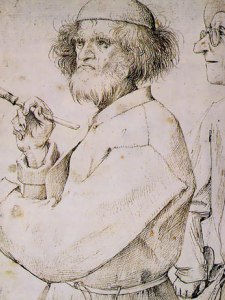Pieter Brueghel, who was also known as Brueghel the Elder, is one of the most important Flemish painters of the sixteenth century.
He showed with faithfulness the life of the Flemish people and was one of the biggest artists of his period. In his works, the taste for the anecdote is found simultaneously with a compositive amplitude and with a strict sense of the rhythm and the synthesis that subordinates the detail to the vision of the artwork as a whole.
Since he visited Italy and contemplated the Alps, nature played in his work an important role and it often became the main motif, being treated in a heroic way. Brueghel represented the men’s works, their games and their fights, in contrast to the unalterable and supreme indifference of nature. With this panoramic vision of the world, Brueghel illustrated an essential aspect of the Humanist thought. His training period took place in the studio of Pieter Coecke, whose daughter Brueghel got married to, some years later. After visiting Italy (1552 - 1553), he realized in Antwerp some drawings for the engraver J.Cock. His paintings are dated and signed between 1558 and 1568.
Brueghel’s first works remind us about the fantastic visions of Bosch. A clear example is his work called The Fall of the Rebel Angels (Brussels). Other works are inspired by folklore and by Flemish proverbs, as well as by the peasant-like life of his country. His series of the months or the seasons (Hunters in the Snow, Vienna; The Hay Harvest, Prague; The harvesters, New York) show his genie as a landscaper. He knew how to combine the observation of the details with the grandeur of the panoramas. Brueghel, driven by a deep feeling of the tragic, expressed it in The Blind Leading the Blind (Naples) and in The Beggars (Louvre Museum, Paris).
He turned the popular scenes into one of the main subjects of his painting, as in The Peasant Wedding, or in The Kermesse, in which the Flemish’s proverbial appetite serves as the pretext to display his entire splendor as a painter: the farm worker’s red hats, the godmother’s white caps, the big patches in the servants and musicians’ dresses, etc.
His evangelic accounts take place in beautiful landscapes from Brabant: Census at Bethlehem (Brussels) and Massacre of the Innocents. Although his art was popular inspired and it had a humorous character, in Flandes, Brueghel was one of the most precocious painters of the Italian Renaissance. Instead of depicting the man’s conception formulated by the Italian Idealism, he depicts a man which is only human and which is an integral part of the universe, and that sometimes is hostile or indifferent. We can see this in The tempest (Vienna) or in The Misanthrope (Naples). 40 paintings by Brueghel are preserved and the best representation of his work is in the Kunsthistorisches Museum in Vienna (14 paintings).


